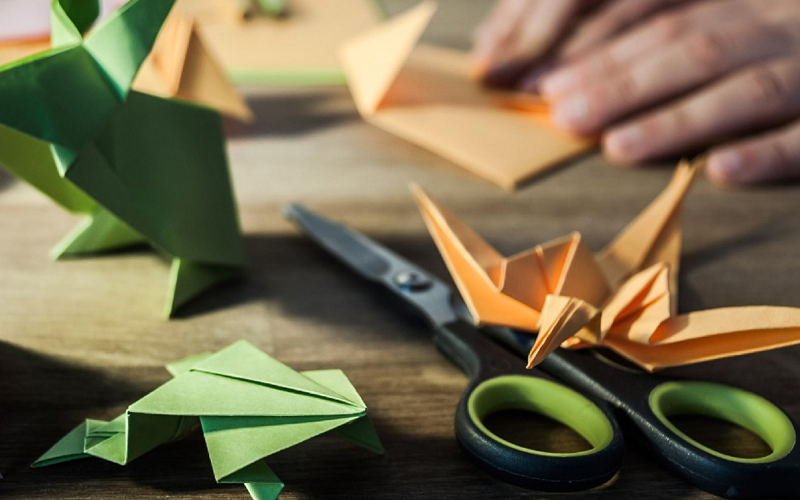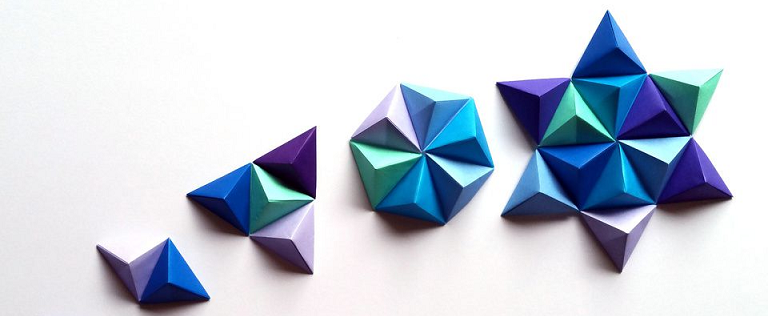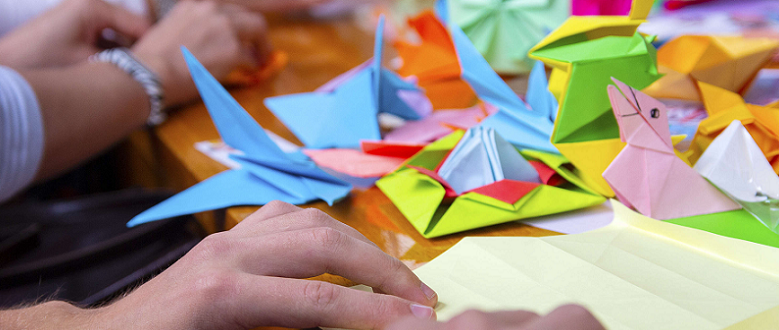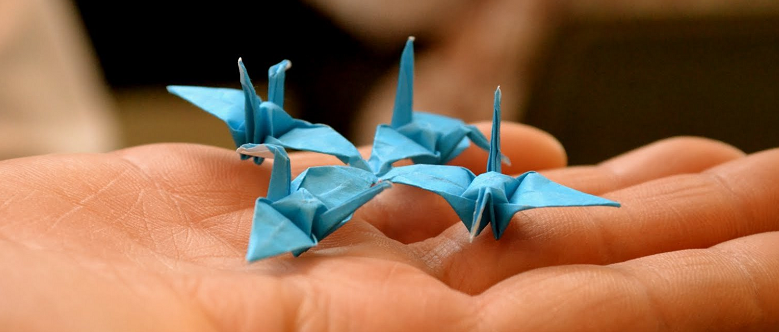
Origami, the ancient Japanese art of paper folding, has captivated people around the world for centuries with its intricate designs and fascinating history. With a simple sheet of paper and some clever folds, artists and enthusiasts alike can create a world of complex shapes and models. From traditional cranes to modern designs, origami has evolved into a diverse and fascinating art form.
Origami as an Art Form
Origami is the ancient Japanese art of paper folding, in which a flat sheet of paper is transformed into a three-dimensional form through a series of precise folds. Origami is not just a craft, but a fascinating art form that has captured the attention of people around the world for centuries.
Origami has a rich history that dates back over a thousand years to the Heian period in Japan. The first recorded use of origami was in the form of paper offerings made at Shinto shrines. It was during the Edo period, from 1603 to 1867, that origami began to gain popularity as a form of entertainment, particularly among the samurai class. During this time, the first origami books were published, detailing the steps to create various models.
Today, origami has evolved into a diverse and fascinating art form that has expanded beyond traditional Japanese designs. Contemporary origami artists create intricate and detailed models that push the boundaries of what is possible with a single sheet of paper. These artists often draw inspiration from nature, architecture, and abstract forms, and their designs range from realistic animals to complex geometric shapes.
Origami has cultural significance not just in Japan, but around the world. In Japan, origami is often associated with the art of gift-giving and is used to create elaborate gift wrappings. Certain origami models also have symbolic meanings, such as the crane, which is said to bring good luck and longevity. In addition, origami has been used in therapy and education, as it can help improve hand-eye coordination and concentration.

The Basics of Origami
Origami is the ancient Japanese art of paper folding, in which a flat sheet of paper is transformed into a three-dimensional form through a series of precise folds. The basic principles of origami involve creating precise folds and creases in the paper, which can then be used to create a wide variety of models, from simple shapes to more complex designs. In this article, we will explore the basics of origami, including the fundamental folds and techniques used in this art form.
The first step in origami is to select the appropriate paper. Origami paper is typically square and comes in a variety of colors and patterns. The thickness and texture of the paper can affect the ease of folding, and different types of paper can be used depending on the complexity of the model. For beginners, it is recommended to use thinner paper as it is easier to fold.
The next step is to learn the basic folds used in origami. The most commonly used folds are the valley fold, the mountain fold, and the diagonal fold. A valley fold is made by folding the paper towards you along a line, while a mountain fold is made by folding the paper away from you along a line. A diagonal fold is made by folding the paper diagonally, forming a triangle.
These basic folds can be combined to create more complex shapes and models. For example, a simple paper crane can be created by combining a series of valley and mountain folds, along with diagonal folds to create wings and a tail.
As you become more familiar with the basic folds, you can start to experiment with different techniques, such as reverse folding, pleating, and sinking. Reverse folding is used to create sharp edges and precise angles in the model, while pleating involves creating a series of parallel folds to create a more complex design. Sinking is a technique used to fold in part of the paper to create a more detailed model.
In addition to learning the basic folds and techniques, it is also important to develop good folding habits. These include creasing the paper firmly, aligning the edges and corners precisely, and using your fingers to shape the model as you fold. Patience and precision are key to creating successful origami models.

Advanced Origami Techniques
Advanced origami techniques take paper folding to the next level, allowing for the creation of more complex and intricate models. These techniques require patience, precision, and a deep understanding of the basic folds and principles of origami. In this article, we will explore some of the advanced origami techniques used by experienced artists to create stunning models.
Wet-Folding
Wet-folding is a technique that involves dampening the paper before folding, which allows for more organic curves and shapes. The dampness makes the paper more pliable, so it can be manipulated and shaped more easily. This technique is often used to create models with more natural shapes, such as animals and plants.
Origami Tessellations
Origami tessellations are created by folding a single piece of paper multiple times to create a repeating pattern. This technique can create complex, three-dimensional designs that resemble origami quilts or mosaics. Tessellations require a lot of patience and precision, as the folds must be consistent and the patterns must line up perfectly.
Modular Origami
Modular origami involves creating multiple units that are then joined together to form a larger model. This technique can create intricate designs that would be difficult to create with a single sheet of paper. Modular origami models can range from simple cubes and spheres to complex polyhedra and shapes.
Box-Pleating
Box-pleating is a technique that involves creating a series of parallel folds in the paper, creating a pleated effect. This technique is often used to create models with sharp angles and precise edges, such as buildings and geometric shapes. Box-pleating requires a lot of precision, as the folds must be consistent and the angles must be exact.
Curved Folds
Curved folds are used to create more organic shapes and curves in origami models. This technique involves creating a series of small, incremental folds to create a curved shape. Curved folds can be combined with other techniques, such as wet-folding, to create more complex shapes and designs.

The Cultural Significance of Origami
Origami is not just an art form, but also has cultural significance that extends beyond Japan. In Japan, origami is associated with the art of gift-giving and is used to create elaborate gift wrappings. Certain origami models also have symbolic meanings, such as the crane, which is said to bring good luck and longevity. In this article, we will explore the cultural significance of origami, both in Japan and around the world.
In Japan, origami is deeply rooted in the country’s cultural traditions. The art of gift-giving is highly valued in Japan, and the presentation of the gift is just as important as the gift itself. Origami is often used to create intricate and beautiful gift wrappings, which are meant to convey respect and appreciation. The colors and patterns of the paper used in origami are also significant, with certain colors representing different emotions or qualities. For example, red is associated with good luck and happiness, while black is associated with mourning and sadness.
Certain origami models also have symbolic meanings in Japanese culture. The crane, for example, is considered a symbol of peace, good luck, and longevity. According to legend, folding a thousand cranes can bring good luck and grant a wish. The crane is also a symbol of hope and healing, and is often used in memorials and peace demonstrations.
Beyond Japan, origami has also gained cultural significance in other parts of the world. In China, origami is known as zhezhi and has a long history dating back to the Tang Dynasty. In Islamic culture, the art of paper folding is known as kirigami, which involves cutting and folding paper to create intricate designs. In the Western world, origami has become a popular hobby and is often used in art and design.
Origami has also been used in therapy and education, as it can help improve hand-eye coordination, concentration, and mental wellbeing. In therapy, origami is often used to help individuals with physical or emotional challenges improve their dexterity and hand control. In education, origami is used to teach geometry, fractions, and other mathematical concepts.
Famous Origami Artists and Their Work
Origami is an art form that has captured the attention of people around the world, and has produced many famous artists whose work continues to inspire and captivate audiences. In this article, we will explore some of the most famous origami artists and their contributions to the art form.
Akira Yoshizawa
Akira Yoshizawa is considered the father of modern origami. He developed many of the techniques that are used today, including the wet-folding technique, which allows for more organic curves and shapes. Yoshizawa created over 50,000 models in his lifetime, and his work is known for its simplicity and elegance. He is also credited with popularizing origami around the world, with his exhibitions and workshops helping to spread the art form beyond Japan.
Robert Lang
Robert Lang is a mathematician who has combined his knowledge of math and science with his passion for origami. Lang is known for his complex and scientifically accurate origami models, which have been used in fields such as robotics and space exploration. He has also authored several books on origami, including “Origami Design Secrets,” which explores the mathematical principles behind origami design.
Satoshi Kamiya
Satoshi Kamiya is known for his intricate and lifelike animal designs. His work is characterized by its complexity and attention to detail, and his models often require hundreds of steps to complete. Kamiya’s models include a wide range of animals, from a dragon to a rhinoceros, and his work has been featured in exhibitions and competitions around the world.
Eric Joisel
Eric Joisel was a French artist who specialized in creating origami sculptures. His work is known for its lifelike and detailed designs, which often depict human figures and faces. Joisel’s work has been exhibited in galleries and museums around the world, and he is considered one of the most innovative and skilled origami artists of his generation.
Michael LaFosse
Michael LaFosse is known for his origami designs that combine traditional techniques with modern materials. He has created a wide range of models, from insects and animals to abstract shapes and designs. LaFosse is also an author and instructor, and has helped to popularize origami as a hobby and art form around the world.
